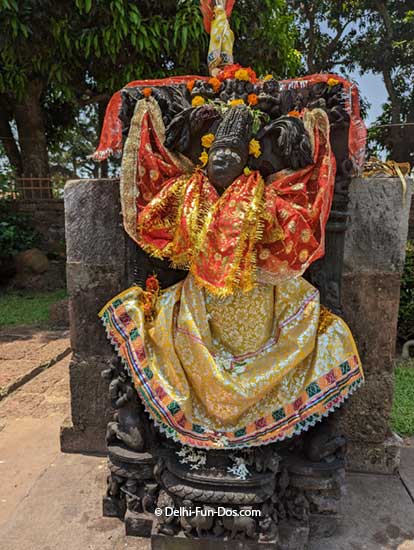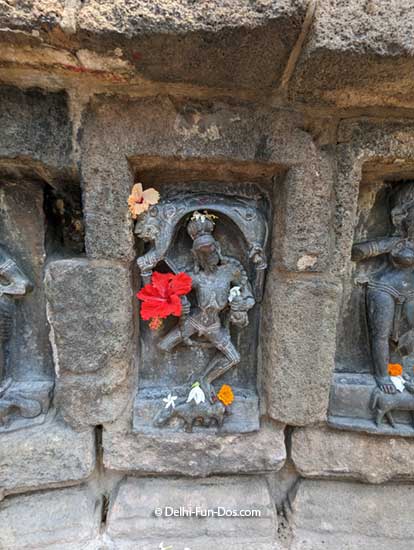When it comes to the architectural marvels of India, the Indian Parliament stands out as a symbol of modern democracy and heritage. However, few people realize that its design is inspired by an ancient and enigmatic source: the Yogini Temple. This connection to the past not only highlights the depth of Indian architectural traditions but also reveals fascinating aspects of cultural continuity in Indian history.
Contents
What is a Yogini Temple?
Yogini Temples are unique structures from the 9th to 12th centuries in India, dedicated to yoginis—female masters of yoga in Hindu Tantra. These temples are often associated with goddesses, especially Parvati, and embody the sacred feminine force. Intriguingly, many of these temples are roofless and feature niches that house statues of 64 yoginis, earning them the name Chausath Yogini Temples (Chausath meaning 64 in Hindi).

For many years, Yogini Temples were largely unknown and unstudied by scholars. However, they have garnered attention in recent decades for their architectural significance and spiritual importance. Among these temples, the Chausath Yogini Temple in Mitawali, near Gwalior in Madhya Pradesh, has been cited as a direct inspiration for the design of the Indian Parliament building.
The Chausath Yogini Temple, Hirapur
The temples of Odisha are some of the best instances of architecture across the world. During our recent visit to Jagannath Temple in Puri, we had an extra day to explore the rich cultural tapestry of Odisha. Known for its traditional art and architecture, Odisha offered a chance to discover something distinct from the grandeur of Jagannath Temple.
PIN IT FOR LATER READ

We decided to visit the Chausath Yogini Temple in Hirapur, located near Bhubaneswar. This temple, built in 864 CE by the Bhouma dynasty queen Hiradevi, is the earliest of its kind in India, predating the Mitawali temple. According to local legends, Goddess Durga manifested as 64 goddesses to vanquish a demon. This is symbolically represented in the temple’s design.

The architecture of the Hirapur temple is unlike any typical temple. Constructed like a mini citadel from stone, it features an array of niches, each housing a black stone statue of a yogini. We could identify Goddess Chamunda from her emaciated features that looked so formidable in stone.

At the centre, a small canopy shelters some yogini statues surrounding a Shiva idol. This unique layout reflects the temple’s role in minimalistic worship practices, where locals traditionally offered flowers. Earlier it was like a magic zone with esoteric practices.
This time we saw that the common Hindu worship style has pervaded this place, with a priest now present for visitors.
How to Reach the Chausath Yogini Temple Hirapur

Bhubaneswar, the capital of Odisha, is well-connected by both flights and trains. From Bhubaneswar, the Chausath Yogini Temple is about 20 kilometers away. You can easily book a taxi for a round trip to this historic shrine and back.
Other Attractions Near the Yogini Temple
Bhubaneswar is a city rich in historical, architectural, and cultural significance. During our visit, we explored several notable attractions:
Lingaraj Temple
This ancient stone-carved temple predates the Jagannath Temple. Dedicated to Shiva, it boasts 108 smaller shrines spread across a vast area. These shrines house Shiva Lingas and exquisite statues of other deities. The Lingaraj Temple has been a site of continuous worship for centuries.
Raja Rani Temple
Located not far from Lingaraj Temple, this 11th-century sandstone temple was originally dedicated to Shiva. Though it no longer serves as an active place of worship, its intricate carvings on the gates and outer walls make it a must-visit for architecture enthusiasts.
Nandan Kanan
A state-run zoo and botanical garden, Nandan Kanan offers an immersive safari experience. Visitors can observe lions, tigers, and bears in habitats that closely mimic their natural environments. It’s a delightful destination for both young and old.
Bell Metal Craft
Balkanti in Hirapur is renowned for its bell metal craft. Here, artisans create both contemporary vessels and traditional artful bowls and lamps. A visit to this craft center provides a glimpse into Odisha’s rich artistic heritage.
Why Visit the Chausath Yogini Temple, Hirapur?
Despite its small size, the Chausath Yogini Temple holds immense cultural and spiritual significance. Its roofless architecture is a rare sight, and the temple’s rituals are conducted in open space, reflecting a unique approach to worship. The temple venerates the five elements of nature—fire, water, earth, sky, and ether—and features yoginis in various expressions, from anger to joy.

The main deity, Mahamaya, dressed in red cloth, and the 60 niches adorned with yogini statues make this temple a captivating destination for art lovers and cultural enthusiasts alike. The temple’s architectural and spiritual uniqueness makes it a worthwhile visit for anyone interested in the rich tapestry of Indian history and culture.
The Chausath Yogini Temple in Hirapur offers a window into India’s architectural and spiritual past, providing a fascinating contrast to the modern grandeur of the Indian Parliament. Whether you’re a history buff, an art enthusiast, or simply curious about India’s rich cultural heritage, a visit to this temple is an enriching experience that connects the ancient with the present.




The Chausath Yogini temples are enveloped in an aura of mystique. Of course, they are known for their architecture, but we were intrigued by these temples’ genesis. We visited the one near Bhedaghat in Madhya Pradesh and was amazed by its vibes. Would love to visit the Hirapur one and also the one in Morena.
So much rich history we have, isn’t it. First time came to know about the Yogini temple & its history.
Indeed worth a visit.
Chousath yogini temple in Hirapur seems an amazing architectural masterpiece. Indeed ancient architecture in India stands out from the rest of the world
Wow, this looks like it was such an incredible place to explore! I would love to be able to see this ancient site in person and understand more deeply the inspiration it gave for one of the most important buildings in India. It sounds like a wonderful experience.
Wow! Thanks for sharing this wonderful information. This is my first time knowing and I am thankful because I can somewhat learned something new.
WOW, how amazing and the history I’m sure of the Chousath yogini temple in Hirapur sounds fascinating. I would love to be able to see this ancient site and learn more about the history, the architectural is indeed astonishing!
I love how the design of this modern building was inspired by An open space ancient temple. India is so intriguing. Thank you for the review!
This was such an interesting read! I’d never heard of temples like these before, and I find it so fascinating.